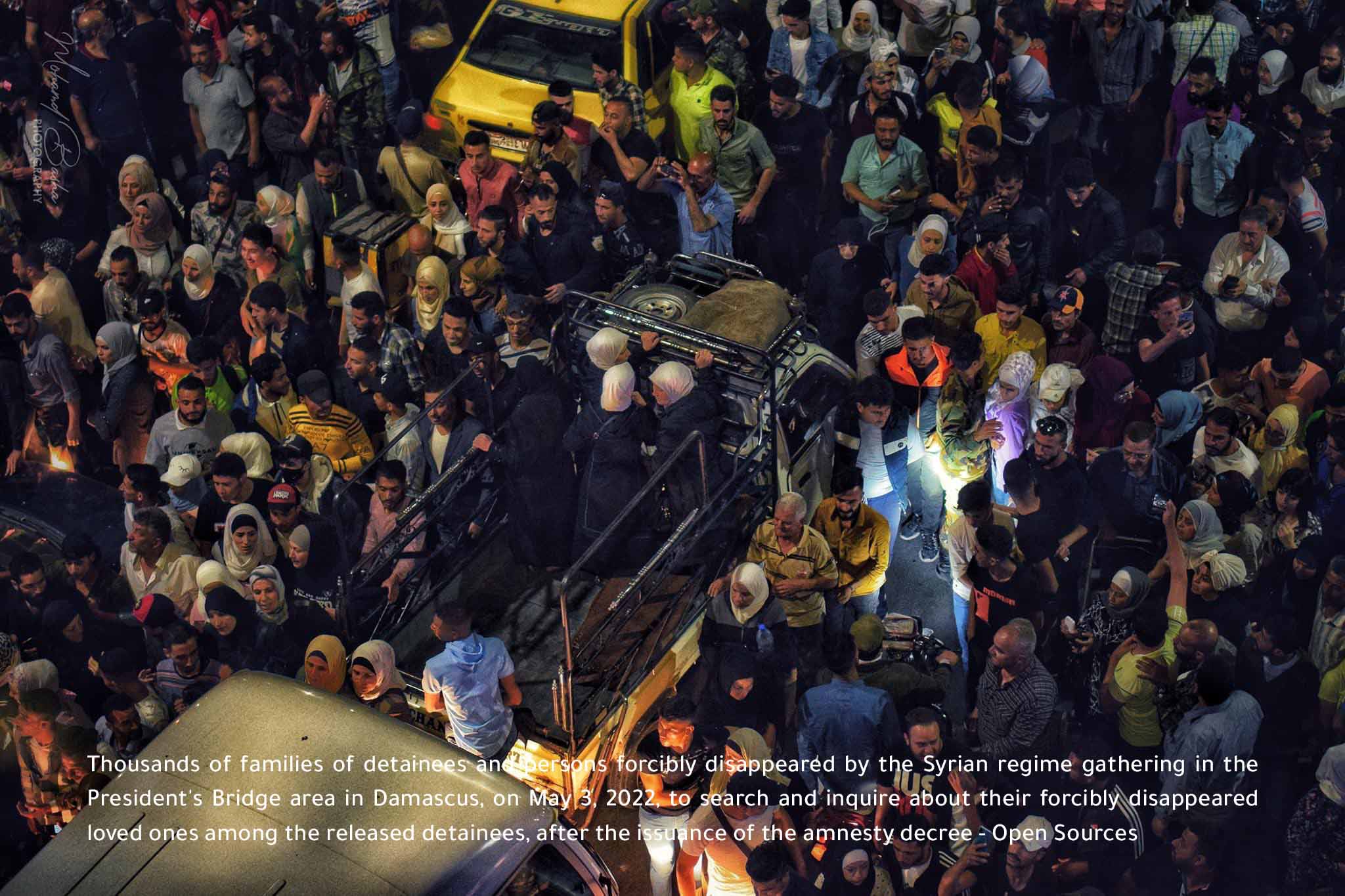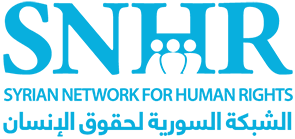Amnesty Decree 7/2022 Is the 19th Since March 2011, and 87.000 People Are Still Forcibly Disappeared by the Syrian Regime

Languages
Available In
Press release:
Paris – The Syrian Network for Human Rights (SNHR) reveals in its report released today that the Syrian regime has released 476 people under Amnesty Decree 7/2022 and is still detaining some 132,000 others in connection with the popular uprising since March 2011, noting that the Amnesty Decree 7/2022 is the nineteenth decree since March 2011 and that 87.000 people are still classified as forcibly disappeared by the Syrian regime, which hasn’t stopped carrying out arbitrary arrests.
The report adds that these decrees are a clear symbol of the regime’s absolute tyranny that can transcend the constitution, constitutional law, and the spirit of laws, expressing Assad’s unlimited power.
The 18-page report notes that an amnesty law was issued by legislative decree No. 7 of 2022 on April 30, 2022; according to the text of the decree, it includes “terrorist crimes committed by Syrians before the date of April 30, 2022, except for those which caused death to a human being, as stipulated in the Counter-Terrorism Law No. 19 of 2012 and the General Penal Code.”
The report provides an analysis of the text of the decree, and the releases of detainees resulting from it, which SNHR’s team has been able to document since the decree’s issuance. The report relies on information obtained from detainees who are still detained in civilian prisons in the Syrian governorates, their lawyers, and their families, as well as from a number of those who were released under Decree 7/2022, providing four testimonies in this context.
The report provides a record of the Syrian regime’s detainee releases documented by the SNHR team since the issuance of Decree No. 7 on April 30, 2022, up until May 11, 2022, for those arrested in connection with participation in the popular uprising, who are routinely charged with ‘terrorism.’ The report distinguishes between the record of the releases related to the amnesty decree and those not related to it, which took place due to the expiry of those detainees’ sentences, stressing that it presents cases involving detainees whose arrest was politically motivated and is not concerned with cases of release of actually criminal detainees charged with theft, forgery, and similar offences. The report also presents the results of the initial analyses, all of which have been cross-checked with the existing data stored in the SNHR’s archive as documented by SNHR regarding the detainee releases resulting from the decree.
The report notes that despite this amnesty’s terms being theoretically slightly broader than those of its predecessors, it does not differ in implementation from any of the preceding amnesty decrees. In this context, the report lists seven key points that make Legislative Decree No. 7 of 2022 another document empty of any real significance, similar to the eighteen amnesty decrees issued by the Syrian regime since 2011, all of which failed to secure the release of any of the detainees arrested and imprisoned in connection with the popular uprising.
The report reveals that at least 132,000 of the Syrian citizens arrested by Syrian regime forces between March 2011 and May 2022 are still classified as detained or forcibly disappeared in regime prisons. During the first ten days following the issuance of Amnesty Decree 7/2022, from May 1-11, 2022, the report documents the release of around 476 people from various civil and military prisons and security branches in the Syrian governorates, including 55 women and 13 people who were children when they were arrested.
In addition, at least 98 of the 476 released people had settled their security status prior to their arrest and been given a supposed guarantee according to the terms of these settlements that they would not be persecuted by regime security authorities; eighteen of those released, including two women, had been refugees or otherwise living outside Syria and were arrested on their return to the country, while at least 12, including three women, were Palestinian refugees.
The report provides preliminary data analysis of the releases related to Decree 7/2022 during the same period, noting that the detainees were released in groups. The report also presents charts showing the distribution of the 476 released people according to the date of release.
In addition, the report makes a comparison between the record of released detainees and the record of the forcibly disappeared in each Syrian governorate according to the location of the arrest incident, revealing that at least 86,792 of the individuals arrested by Syrian regime forces since March 2011 are still classified as forcibly disappeared by regime forces as of August 2021. As the report adds, the comparison very clearly shows that the number of released people accounts for approximately 0.10% on average of the documented total number of forcibly disappeared people in each of the governorates in which the comparison was made, a stark percentage which proves that, at the current woefully low rate of releases, it would take hundreds of years for the Syrian regime to release these detainees and forcibly disappeared persons held in regime detention centers; this once again underlines the fraudulent and wholly inadequate nature of these amnesties.
The report also presents charts showing the distribution of the record of those released according to detention centers, and according to the exceptional courts at which they were tried.
As the report further notes, the Syrian regime also deliberately inflicted additional moral and material harm on the detainees’ families and insulted the released detainees’ dignity through Decree 7/2022 and its implementation procedures; the regime deliberately released small numbers of detainees in several groups from detention centers, dropping them off in public squares without handing them over to their families or even contacting their families to notify them of their loved ones’ release. This caused a state of panic among the released and among the families of detained and forcibly disappeared people, leading thousands of distraught family members of detainees and forcibly disappeared people to gather in these locations to search frantically for their disappeared loved ones among the small numbers of released people, carrying photos of their loved ones in order to inquire about them. Despite the passage of many years, the Syrian regime has never provided any real mechanism to enable families of detainees and forcibly disappeared people to find out the fate of their loved ones. In addition, the Syrian judiciary has never announced the names of those covered by these amnesties. The report adds that this is the main reason behind the families of detainees and the forcibly disappeared being exposed to cruel and extortionately expensive incidents of fraud at the hands of networks of regime officials involving judges, lawyers, officers, and influential figures who take advantage of the families’ desperation to hold out hope that they can ensure that their detained or forcibly disappeared loved ones are included in the amnesty decree in exchange for huge sums of money.
As the report notes, many of the photos that SNHR obtained, which it has verified, showed the poor health of the released detainees after they were held in extremely poor and unsanitary conditions in detention centers where they had clearly been subjected to torture, as well as enduring an almost complete lack of healthcare and medical care, as well as severe overcrowding, adding that the conditions of detainees who have been missing for a period of up to 11 years is much worse if they have survived.
The report stresses that the Syrian regime is the party responsible for forcing detainees to confess to acts they did not commit, trying them on the basis of these false coerced confessions, and then issuing a partial amnesty for them; this manufactured cycle aims to blackmail detainees and their families and to increase their suffering, and constitutes a violation of the most basic principles of human rights.
The report adds that the Decree No. 7 of 2022 did not include political detainees or those detained in connection with their expression of opinion, or activists in the popular uprising. In addition, the amnesty does not include the vast majority of detainees who have not been charged or referred to any courts, many of whom have been detained for several years. The report further notes that there is a lack of any clear criteria for selecting and releasing detainees included in the amnesty and that most of those released were civilians, who had been arbitrarily arrested and framed on charges of terrorism, under which they were tried in exceptional courts that lack the most fundamental legal standards of justice or degrees of litigation, who were granted amnesty, and released.
The report notes that the Syrian regime has not only brought charges against and tried detainees under the General Penal Code’s articles related to crimes against state security, but has also issued a Counter-Terrorism Law, in which it provides vaguely defined articles and ambiguous, non-specific definitions of terrorist acts and conspiracy, according to which the largest possible number of detainees could be tried before the Counter-Terrorism Court, with the legislation leaving room for the judges to define and analyze the accusations made according to their own opinions, opening the door to the material exploitation and extortion of any detainee in exchange for his or her release or inclusion in the amnesty decrees issued.
The report adds that originally there was no legal basis for the mechanism for criminalizing and charging political detainees, with charges brought either under the Counter-Terrorism Law or the General Penal Code, based on confessions extracted from detainees under torture and coercion.
The report recommends that the United Nations and the international community should not be deceived by the tricks and ruses of the Syrian regime and should continue to put constant pressure on it to release political and human rights activists, protesters, and all peaceful, democratic opponents and dissidents.
The report also calls on the United Nations and the international community to demand that the Syrian regime reveal the fate of 87,000 forcibly disappeared persons and disclose the fate and whereabouts of the bodies of the many thousands who were killed by torture or executed, as seen in the case of the recently published investigation into the massacre in Damascus’ al Tadamun neighborhood.
The report additionally provides a number of other recommendations.


